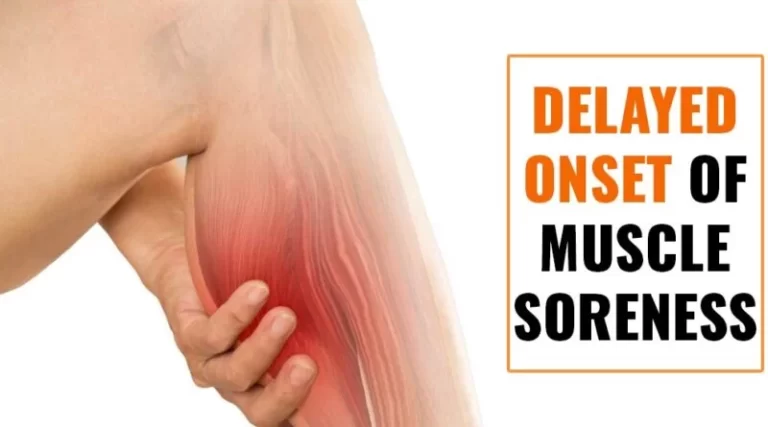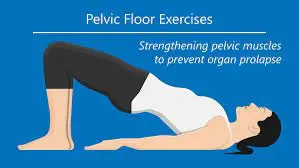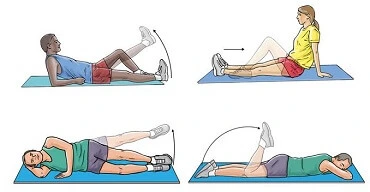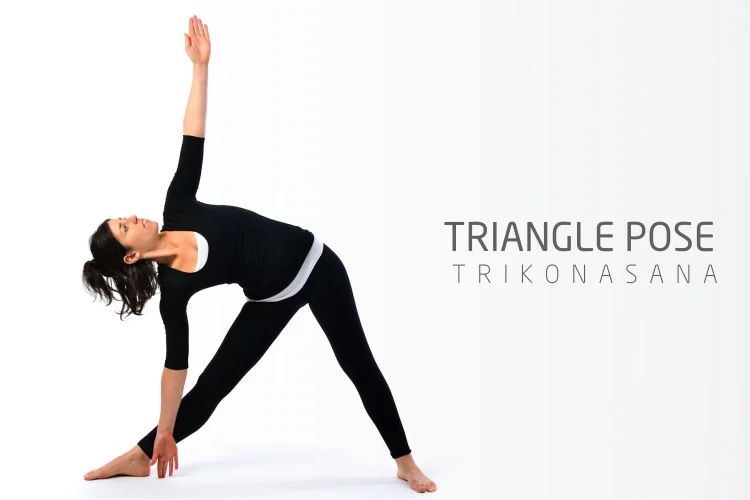Single Leg Deadlift
The posterior chain muscles, which include the hamstrings, glutes, and lower back, are worked out during the popular single-leg deadlift exercise. It is a modification of the standard deadlift workout with an additional stability and balance challenge.
The single-leg deadlift is one of the most complete, effective, and concentrated exercises that anyone can do. It is crucial for achieving maximum strength as well as a healthy spine and core. There are several variations of this activity that work for various audiences and goals. The deadlift is a terrific difficult workout that works both the upper and lower body. It is the undisputed king of exercises.
The single-leg deadlift, also known as the one-leg deadlift, is a wonderful unilateral technique that trains the entire lower body, especially the posterior chain. Its strength in the gym has given rise to an infinite variety of it, one of which is the single-leg deadlift. It builds muscle and strength, but it has other benefits as well!
Table of Contents
What Is a Single-Leg Deadlift?
A true unilateral lower-limb exercise is the single-leg deadlift. One-half of a unilateral exercise is finished at a time. This enables you to identify muscular imbalances and improves your athleticism and balance.
What Muscles Does the Single Leg Deadlift Work?
The single-leg deadlift exercises the upper and lower limbs as well as the muscles in the posterior chain. A closer look at the muscles used may be seen here.
Hamstring
One of the key muscles for this workout is the hamstrings. This muscle group crosses both the knee joint and the hip joint and consists of the biceps femoris (both long and short head), semitendinosus, and semimembranosus. This implies that they engage in activities that involve flexing and extending the hip and knee joints. When performing a single-leg deadlift, the hamstrings assist the glutes and propel the hips forward, providing a good hamstring exercise.
Upper Back:
The single-leg deadlift primarily targets the lower limbs, but it also works some of the upper limbs, especially the back muscles. Your back muscles are triggered by concentrating on drawing your shoulders back together.
During the single-leg deadlift, your back muscles, particularly your scapular muscles (also known as your traps), are highly recruited. Even though that is unusual, you could incorporate this action into your back exercises.
Core (Including Lower Back & Abs):
The term “core muscles” is frequently used to refer to the abdominal muscles. While this is true, the obliques and lower back are also a part of the core (some people even refer to the entire torso as the core).
Together, these muscles contract to cause the spine to become stiff and rigid, encasing the internal organs and bones. These muscles must prevent the torso from twisting during the single-leg deadlift.
Glutes:
The direct muscles involved in deadlift training are the glutes and the hamstrings. While some knee flexion (pointing quad work) occurs, the emphasis here is mostly on hip extension.
These are the many, strong muscles in the human body that are involved in virtually all lower body movements. The gluteus medius is primarily activated in this single-leg deadlift exercise since it is the muscle responsible for maintaining balance on one leg.
Benefits Of The Single Leg Deadlift:
As previously mentioned, the single-leg deadlift will increase physical strength and bulk. But there are other benefits that go beyond simply building muscle and strength.
Here are some more merits of the single-leg deadlift.
The Single Leg Deadlift Works The Posterior Chain: A group of muscles known as the rear chain work together to stabilize the back and open the hips. The glutes, hamstrings, and erector spine are the direct muscles, and they are all crucial for general health, human interpretation, and injury prevention. Given that it is a real hip extension exercise—possibly even more so than a typical deadlift—a single-leg deadlift is an excellent choice for training these muscles.
Unilateral Exercises Work One Leg At A Time: Although we’ve already discussed it, the single-leg deadlift’s concentration on lifting one leg at a time makes it incredibly challenging to return. Due to the activity’s one-sidedness, the remaining benefits are on this list.
The One-Leg Deadlift Improves Balance: One of the elements that distinguish this campaign design and make it essential for any leg activity is the balancing component of the single-leg deadlift. For athletics and in everyday life, everyone needs balance.
Deadlifts on one leg are beneficial for unilateral sports movements: Extremely few sports or daily activities need the use of both legs, therefore unilateral exercise is essential. All unilateral motions, including running, walking, and bicycling. One stage in a demonstration of difference. Despite the fact that bilateral exercises are required for maximal strength development, a single-leg workout will more accurately mirror real-world situations.
You Can Use Lighter Weights: This may seem strange because a regular deadlift provides the function of lifting large weights. However, using really heavy weights isn’t always the best option. Even lesser weights may prevent increased muscular activation, according to studies. Rehab, different phases of periodization, deload weeks, and at-home activities (provided you have weights to utilize) are a few instances when you might wish to apply more subtle consequences.
Single Leg Deadlift Vs Conventional Deadlift
When one leg is removed from the deadlift, the movement and training factors are drastically altered. Here, we demonstrate how they vary.
Hypertrophy Vs Strength: Strength training is the main purpose of the conventional deadlift. While some lifters will utilize more reps for deadlifts, the majority keep under the 5-rep threshold. Even though it should be evident that a one-leg deadlift would need less weight lifting, experts still recommend higher rep ranges (10–12). As a result, it falls within the category of exercises for muscular growth or hypertrophy.
Weight Used: Most people believe that performing a unilateral workout will boost your bilateral counterpart by 50%. However, this is not the issue. Given the amount of study that has been done on the issue, we can say with a high degree of certainty that more weight than this can be raised when using a single leg. In other words, if you execute a single-leg deadlift on your left leg first, then your right leg, the connected load should be larger than the bilateral counterpart. Research that looked at one-leg squats provided evidence for this. According to research, a lifter’s performance in the single-leg squat was 42% of the back squat when looking at the weight of the barbell.
However, the single-leg variant only supported 64% of the body weight. Theoretically, this would equal 128%.
Hormonal Response: The hormonal response to barbell workouts by the body is vital for human growth. Testosterone is one of the hormonal responses. Unexpectedly, research has shown that increasing this anabolic hormone with just one leg would have equal effects. Despite the lighter burden, this continues. This is significant because the unilateral version allows you to keep your testosterone levels up even if you are unable to perform typical bilateral leg workouts.
Single Leg Deadlift Or Single Leg Romanian Deadlift?
Which exercise, the deadlift or the deadlift with one leg, is most similar to the Romanian deadlift? When carrying out a single-leg deadlift, it is possible to become perplexed about what you are doing.
The reality is that it’s unclear which category it belongs in. However, in general, a Romanian deadlift (RDL) and a one-leg deadlift are more similar than not.
Rarely do you see someone begin the move from the bottom. Instead, lifters start from a standing posture, much like the RDL. Even with less knee flexion, individuals can nevertheless drop lower at the exact instant, as seen during a standard deadlift.
Furthermore, many perform single-leg deadlifts to improve balance and hypertrophy rather than power. This can be done more successfully with the RDL.
Additionally, bear in mind that standing on one leg will require more effort but less steady from your stabilizer muscles. You won’t be able to exert as much effort as a consequence, which results in less weight being employed.
There are several other single-leg motions to take into consideration. One of these is the skater squat, which mimics a true single-leg deadlift.
Proper Form For The Single-Leg Deadlift:
Below, we’ll go through a few different single-leg deadlift variants. However, they all have the same main activity. Master the exercise regimen first, then up the weights as you are able. The primary exercise in this how-to is the single-leg deadlift with two dumbbells.
How is the single-leg deadlift done?
Step one of the dumbbells into the beginning position by standing with your feet hip-width apart, leaning forward.
Allow your dumbbells to hang in front of your legs as you stand up properly. While maintaining one leg straight on the ground, kick the opposing leg in the back. While keeping your rear leg generally fully extended can substantially improve your balance, it is not necessary for you to stay in a straight line.
With a Romanian deadlift, you will have a slight soft knee curvature that allows the hips to be pulled back. Letting your trunk sag forward while flexing at the knee, push your hips back. Once more, keep your knee slightly bent and attempt to load your glutes and hamstrings as you lean forward.
Allow your arms to dangle naturally with your palms facing your knees and your arms straight and stretched. Throughout the entire exercise, keep your core firm and your shoulders back.
Maintain as much forward trunk flexion as you can. Your dumbbells should land somewhere in the middle of your shins, but there is no distinct position where they should land. Stop falling when you feel that your form is about to give way. The word “about” to break is stressed.
Raise your hips to begin dragging your weights upward. Focus on pushing your glutes and moving your hips forward to achieve this. Aim to stretch your hips all the way. Until you have completed the required repeat on one leg, you will not stand on your booth legs.
For as many reps as you like, repeat.
Single Leg Deadlift Variations For Beginners:
For lifters of various levels, there are several single-leg deadlift interpretations. Starting with a simpler unilateral variant is still a good option, even if you are a strong deadlift on a power-lifting regimen. This is due to how different serving the exercise is when done on one leg.
It also requires a great deal more balance. Here are four options that each exercise club may use.

Elevated Rear Foot Single Leg Deadlift:
Although similar, this split squat is not a Bulgarian variation. To do the Bulgarian split squat, you will stretch your rear leg back until it is parallel to the floor.
Your leg is nearly stretched if this is the case. Then it will take a seat on a bench, step stool, or platform. The leg is actively contributing to the development of force.
Single Leg Deadlift With Support:
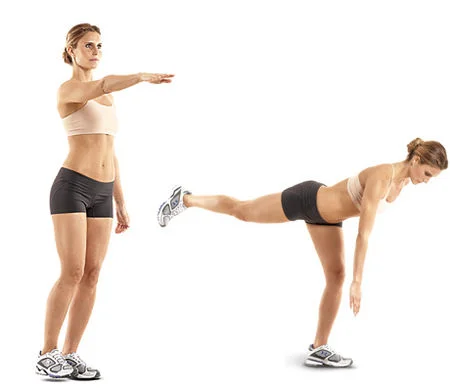
The single-leg deadlift version may be performed on supports such as the rack squat, door, or wall. It’s entirely up to you in a few ways how you use your assistance.
By keeping your back foot on a wall or chair while performing single-leg deadlift exercises, you may start practicing the action and developing your balance. You can hold onto a rack squat (or something similar) with one hand and perform the whole deadlift range of motion.
Your goal is to utilize fewer and smaller amounts of assistance as you proceed through the workout.
Body Weight Single Leg Deadlift:
Once you have adequate balance, you can perform the task using only your body weight.
Before adding weights to the mix, this is a terrific method to get the movement and your balance down.
Single Leg Deadlift with Resistance Band:
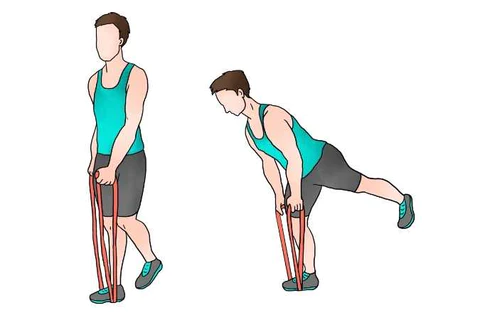
When you can successfully complete a single-leg deadlift without assistance, it’s time to start putting your muscles through some trials. You might start out by using some resistance bands.
To become used to doing the single-leg deadlift with resistance is a fantastic progression. Either place the resistance band beneath your standing leg while holding the ends in your hands or link it to something like a squat stand.
Remember that as you bend forward, this will just barely draw your arms back.
Once you have mastered this deviation, try counting a knee drive in at the conclusion to further test your balance.
Advanced Single-Leg Deadlift Variations:
Depending on your level of fitness, you can proceed through the overhead progressions rather rapidly. When ready, switch to the two-dumbbell variety discussed above, or one of these alternatives.
Single Leg Deadlift With Kettlebell:
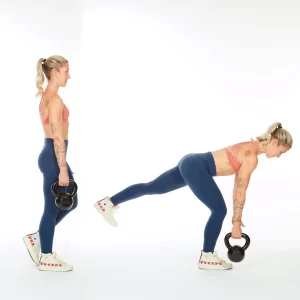
Using a kettlebell could be our preferred method because the grip is simpler to maintain because the weight is underneath your hand. If you choose to use a single kettlebell, hold it in the same side hand as your supporting leg when you are standing. You would hold the kettlebell in your right hand, for instance, if your right leg was in position.
Hold it in your left hand while the left leg is placed. Take one kettlebell in each hand for a pair.
In whatever version, the kettlebell should come to rest exactly balanced like your feet and in a straight line. A pair of dumbbells can also be used in place of a kettlebell.
Barbell Single-Leg Deadlift:
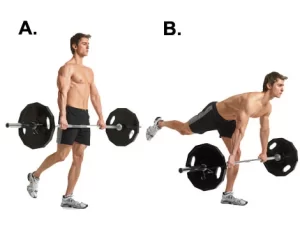
A progressive single-leg deadlift is this. Although it is not frequently used, you can use a barbell, but we only advise experienced lifters to do so. Additionally, the barbell deadlift is the finest variation for trying to leap off the ground.
Every training program must include the single-leg deadlift.
- Individuals aren’t doing single-leg motions well enough. But you can now.
- The single-leg Romanian deadlift is a fantastic exercise for building stronger leg muscles because it strikes an ideal balance between difficulty, mobility, and efficiency. For this reason, it is used in workouts for lifters and athletes at all phases and levels of expertise.
- The one-leg deadlift is fantastic for increasing muscle size, and when done with modest weights and lots of repetitions, it may also be utilized to increase muscular endurance.
- If your fitness routine doesn’t currently include any unilateral exercises, we strongly suggest including the single-leg deadlift. That is assuming you want to make the most of your training, which is what we are expecting.
Common Mistakes & Form Tips:
To profit from all of this move’s potential advantages, getting it is crucial. Use these three tips to ensure that you’re doing it correctly.
- Most people may stoop lower while maintaining proper form since they are just using one leg to stand on. However, even if you can descend, you still need to maintain a straight trunk! To lower your dumbbell, do not turn your body. This will raise your risk of harm and offer no further benefits.
- To avoid defeating the purpose of the workout, do not flex your knee further to allow for more depth. Not going as quietly as you can is your main goal; loading the posterior muscles is. So let’s reiterate the importance of a tiny flexed once more.
- When standing on one leg, the range of motion will be larger. As long as you don’t give form, try getting your trunk parallel to the ground.
FAQs
Do you need to utilize weights for the single-leg deadlift?
Use weight sparingly, depending on your strength and coordination. Even the open bar is quite soothing for some gym attendees. You could want to start adding plates to your barbell as you gain experience and skill to continue making progress.
Is performing single-leg deadlifts bad for my trunk?
No exercise has an inherent risk. It all depends on how you load it and how bearable the processes are. During a single-leg deadlift, your spinal erectors will be slightly engaged, but there should be a clear contrast between muscle weariness and genuine soreness. Look for a different course of action if you are uncomfortable.
Why should you perform single-leg deadlifts?
The single-leg deadlift is beneficial for strengthening the glutes, hamstrings, lower back, and core. With this activity, your balance and motor abilities will both improve.
Can one-legged deadlifts help you build glutes?
Squats might be one of the most well-known lower-body exercises, but single-leg movements strengthen your glutes and legs individually while addressing muscle imbalances just as well.
What kind of deadlift is best for beginners?
The Romanian deadlift is the greatest spot for novices to begin. The trap bar or hex bar deadlift is the next level. The bar’s design and the bar’s high handles let you perfect your deadlift technique while reducing the amount of motion required and the danger of damage.
Why do individuals fear exercising with deadlifts?
The deadlift is a full-body, challenging exercise that might put too much strain on your lower back and lead to a slipped disc or fracture. It is preferable to avoid less strenuous activity when coping with certain health issues to prevent discomfort from getting worse.
Is daily deadlifting bad?
Yes, you can deadlift often and build strength without becoming injured. such as this. Deadlifting is a skill that requires a lot of practice to achieve and is more than simply a show of brute strength. As a result, it’s a movement that may be practiced every day to maintain that rhythm.
Reference
Tirgar, P. (2023, June 28). Triceps Kickback Exercise – Benefits, How to do? – Muscle worked. Mobile Physiotherapy Clinic. https://mobilephysiotherapyclinic.in/triceps-kickback-exercise/
Learn The Single Leg Deadlift: Muscles Worked, Technique, Benefits, And Variations – BoxLife Magazine. (2023, January 27). BoxLife Magazine. https://boxlifemagazine.com/single-leg-romanian-deadlift/
SET, S. F. (n.d.). Single Leg Deadlift: How To, Benefits, & Variations. SET FOR SET. https://www.setforset.com/blogs/news/single-leg-deadlift

